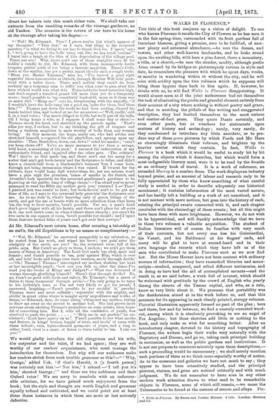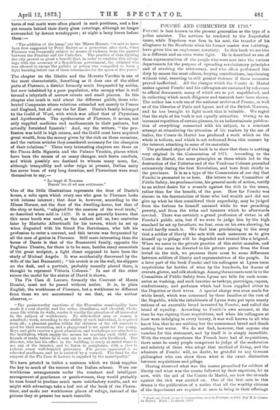WALKS IN FLORENCE.*
THE title of this book conjures up a vision of delight. To one who knows Florence it recalls the City of Flowers as he has seen it in the fair spring-time, surrounded with its fruit gardens full of luxuriant blossom, giving a promise, sure to be fulfilled, of sum- mer plenty and autumnal abundance,—he sees the domes, and towers, and other well-known landmarks, and he looks round upon the swelling hills, with here a pine forest, there a monastery, a villa, or a church,—he sees the slender, muddy, although poetic Arno, crossed by its bridges so picturesquely various in style and date, he remembers the pleasure with which he spent days, weeks, or months in wandering within or without the city, and he will seize with avidity upon the two volumes which he supposes will bring those bygone days back to him again. If, however, he thinks with us, he will find Walks in Florence disappointing. It would almost seem as if the joint authoresses had set themselves the task of eliminating the poetic and graceful element entirely from their account of a city where nothing is without poetry and grace, and that in avoiding the pitfalls of fine writing and exaggerated description, they had limited themselves to the most serious and matter-of-fact prose. They quote Dante certainly, and even other poets, but as vouchers for statements upon matters of history and archaeology ; rarely, very rarely, do they condescend to introduce any little anecdote, or to pro- duce any of those genre pictures by which Forde and Mr. Hare so charmingly illuminate their volumes, and brighten up the heavier matter which they contain. In fact, Walks in Florence is a book which it would be useful to study bit by bit among the objects which it describes, but which would form a most indigestible literary meal, were it to be read by the fireside as an ordinary book of travel. It is a work of reference, an extended Murray in a sombre dress. The work displays an industry beyond praise, and an amount of labour and research only to be fully appreciated by those who know something of what careful study is needed in order to describe adequately one historical monument ; it contains information of the most varied nature, and has hardly left a building or a work of art unnoticed, and it is not content with mere notices, but goes into the history of each, relating the principal events connected with it, and each chapter concludes with the chronology of these events ; but all this might have been done with more brightness. However, we do not wish to be hypercritical, and will frankly acknowledge that we have in these two volumes a valuable acquisition. The student of Italian literature will of course be familiar with very much of their contents, but not every one has his Guicciardini, his Vasari, and his Baldinucci at his fingers' ends, and many will be glad to have at second-hand and in their own language the records which they have left us of the men who contributed to make Florence such as we now find her. But the Misses Horner have not been content with ordinary sources of information ; they have ransacked libraries and manu- scripts—studied, compared, and sifted different testimonies, and in doing so have had the aid of accomplished savants—and the result is, as we said before, a work full of interest, which should 'be welcomed with gratitude by the crowd of English who yearly throng the streets of the Tuscan capital, and who, as a rule, know so very little about it. We presume that portability was the desideratum aimed at in the work before us, and that this accounts for its appearing in such closely-printed, stumpy volumes. Pictorial illustration apparently formed no part of the plan ; here and there, few and far between, we find a coarsely-executed wood- cut, among which it is absolutely provoking to see an angel of Fra Angelico ; but these sketches add little or nothing to the book, and only make us wish for something better. After an introductory chapter, devoted to the history and topography of Florence, the writers begin their walks very naturally with the Baptistery and Dimino, and go on, taking each principal building in succession, as well as the public gardens and institutions. It is not our purpose to comment minutely upon these descriptions,— such a proceeding would be unnecessary ; we shall merely mention such portions of them as we think more especially worthy of notice.
As to the museums and galleries we have not much to say ; they appear to have been attentively studied, and the principal pictures, statues, and gems are noticed critically and with much judgment. We do not remember to have seen in any other modern work attention drawn to what used to be remarkable objects in Florence, some of which still remain,—we mean the Tabernacles to be found at the corners of streets and alleys. Pic-
* Walks in Florence. By Susan and Joanna Homer. 2 vols. London: Stmhan and Co.
tures of real merit were often placed in such positions, and a few yet remain behind their dusty glass coverings, although no longer surrounded by devout worshippers ; at night a lamp burns before them :—
" The addition of the lamp," say the Misses Horner, "is said to have been first suggested by Peter Martyr as a protection after dark, when Florence was frequently subject to scenes of violence, from the quarrel between the Paterini and the Catholics. The practice of thus lighting the city proved so groat a benefit that, in order to combine this advan- tage with the economy of a Republican government, the criminal who was allowed to escape the galleys or prison was compelled to keep a light burning before one of these tabernacles for the space of five years."
The chapter on the Ghetto and the Mercato Vecchio is one of the most characteristic, describing as it does one of the oldest parts of Florence, a district formerly much frequented by nobles, but now inhabited by a poor population, who occupy what is well termed a labyrinth of narrow streets and small piazzas. In this chapter also much is said about the different guilds, those cele- brated Companies whose relations extended not merely to France and England, but all over the far East. Dante's family belonged to the Guild of Wool, with which was allied that of Physicians and Apothecaries. The apothecaries of Florence, it seems, not only supplied medicine and medicaments to their patients, but actually furnished funerals ! And, say the writers, " the pro- fession was held in high esteem, and the Guild must have acquired great wealth, from the money given by the rich on these occasions, and the various articles they considered necessary for the obsequies of their relations." Three very interesting chapters are those on the Piazza della Signoria and the Palazzo Vecchio, places which have been the scenes of so many changes, such fierce conflicts, and which possibly are destined to witness many more, for, although tranquillity and order reign at present, Italian unity Las never been of very long duration, and Florentines were wont themselves to say,-
" Le leggi di Toscana
Duran' tre di ed luta settimana."
One of the little illustrations represents the door of Dante's
house, a relic upon which every one who goes to Florence looks with intense interest ; that door is, however, according to the Misses Horner, not the door of the dwelling-house, but that of the shop or booth, " adapted for the exercise of the wool trade," so described when sold in 1429. It is not generally known that
this same booth was used, as the authors tell us, two centuries later by Mariotto Albertinelli for his tavern, which he set up when disgusted with his friend Fra Bartolomeo, who left his profession to enter a convent, and this tavern was frequented by all the men of genius in Florence. Still more interesting than the house of Dante is that of the Buonarotti family, opposite the Pagliano Theatre, for there is to be seen, besides many memorials of the great sculptor, a light closet supposed to have been the study of Michael Angelo. It was accidentally discovered by the wife of the last Buonarotti ; " his crutch is on the wall, his slippers on the desk, and a portrait, probably recently placed there, is thought to represent Vittoria Colonna." In one of the other rooms the model for the statue of David is shown.
The Pia Casa di Lavoro, formerly the Convent of Monte Domini, must not be passed without notice. It is, in plain English, the workhouse of Florence, but a workhouse so different from those we are accustomed to see that, as the author observes,—
" The praiseworthy exertions of the Florentine municipality have made it a real charity, and the order, cleanliness, and cheerful, whole- some life within its walls, render it worthy the attention of all interested in the subject of workhouses. No able-bodied man or woman is admitted ; work, according to the ability of each individual, is required from all ; a pleasant garden within the cloisters of the old convent is used for their recreation, and a playground is set apart for the young. Boys and girls receive a good education, and workshops are attached to the institution, which supply the means for teaching each child some branch of trade, before he is sent out to earn his own livelihood. The' director, who has his office in the building, is ready at stated times to see any of the inmates, and to listen to complaints, with a view to redress every well-founded grievance. The person appointed is an educated gentleman, and he is assisted by a council. The fund for the support of the Pia Casa di Lavoro is supplied by the municipality."
We have printed in italics a sentence which we think supplies the key to much of the success of the Italian scheme. Were our workhouse arrangements under the constant and intelligent management of gentlemen or gentlewomen, they would probably be soon found to 'produce much more satisfactory results, and we might with advantage take a leaf out of the book of the Floren- tines, and make our workhouses places of refuge, instead of the prisons they at present too much resemble.



































 Previous page
Previous page